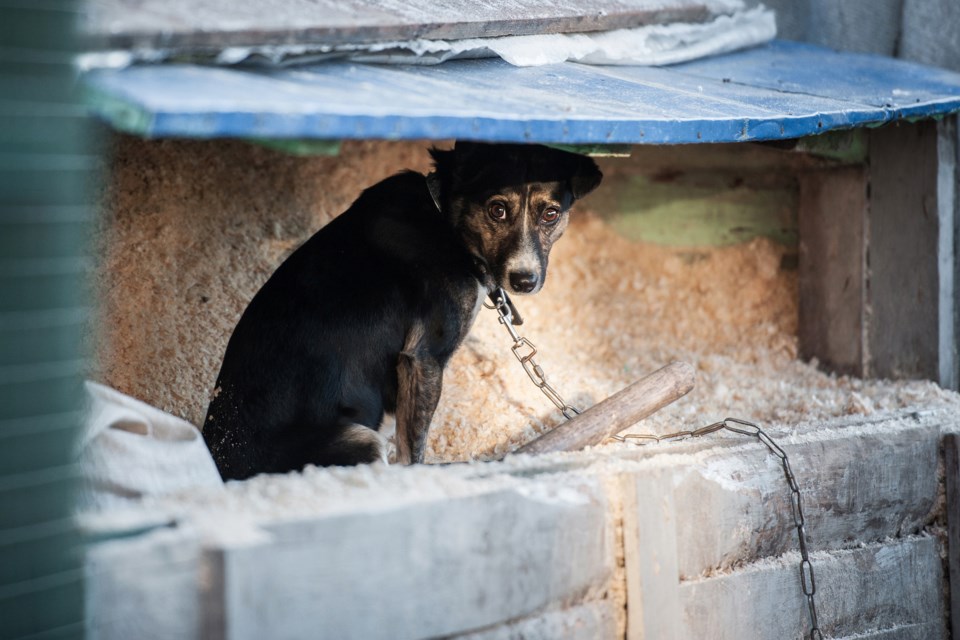How long should people be allowed to chain up their dogs outside? According to the Ontario government, the answer is 23.5 hours per day.
That number — as shocking as it may sound to canine lovers across the province — is at the heart of a Ford government proposal that’s actually meant to bolster animal-protection legislation, which currently sets zero limits on the amount of time dogs can be tethered outdoors.
Under the recommended updates, any dog tied up for more than 24 consecutive hours would need to be “provided off-tether time of at least 30 minutes” to “allow for sufficient exercise and enrichment.”
In other words, it will be perfectly legal to leave a dog roped to a post for the other 23.5 hours in a day.
Does that seem reasonable? Humane? The province wants your opinion — and the deadline for feedback, March 7, is fast approaching.
“I think the proposals are woefully inadequate,” says Camille Labchuk, a lawyer and executive director of Animal Justice, a national advocacy group. “I’m shocked that the government would even bother putting this forward, because it’s not much of a change from existing standards that are already very, very poor.”
Widely praised when it came into force in 2020, Ontario’s Provincial Animal Welfare Services Act (PAWS) created the country’s first-ever government enforcement agency focused on animal protection. Last year alone, provincial inspectors executed approximately 120 warrants and laid more than 330 charges linked to alleged violations.
However, the Ford government now concedes that within the Act, the specific regulations about dogs left outdoors need to be modified because they are “vague” and “limited in their scope.”
“The proposed updates would establish a definition of a dog ‘kept outdoors,’ as well as the standards of care that apply to these animals with respect to their physical environment, health and nutrition,” reads the government’s request for public feedback, posted online. “New standards for the care of dogs kept outdoors are being proposed to address challenges with the existing standards, public concerns raised about the welfare of dogs outdoors, as well as to ensure the standards are reflective of the most recent evidence and practice.”
Many of the proposals appear to be obvious improvements: Structurally sound, ventilated and weather-proofed doghouses. Pens large enough for animals to eat, drink, rest and relieve themselves. Access to shade, sufficient food and a continuous source of clean, unfrozen water. Regular grooming, including nails and paws.
But only 30 minutes a day to roam free? That proposal is sure to unleash plenty of anger.
“Inmates get more exercise than that,” Labchuk says. “It’s appalling.”
Research has shown that long-term tethering presents a risk to both the animal and public safety. Dogs tied up for long periods of time are not able to run, socialize, explore or express other natural behaviours, which can trigger boredom, depression, frustration, anxiety and aggressiveness.
Animal welfare advocates have been especially critical of commercial sled dog operations, where cases of neglect and abuse are well-documented.
Despite years of public outcry, there is nothing to stop people in most provinces and territories from tying up their dogs indefinitely — as long as the animals aren’t in obvious “distress” and they have an adequate supply of food and water.
But in Nova Scotia, for example, the rules are much more strict: no animal can be tethered for more than 12 hours during any 24-hour period. In neighbouring New Brunswick, it is illegal to chain a dog outside between 11 p.m and 6 a.m.
Ontario’s potential changes lie somewhere in between. While nowhere close to a blanket ban on outdoor tethering — as this online petition demands — the new rules will at least save dogs from being tied up alone for days on end. The wording also makes clear that dogs cannot be chained up if they are less than six months old, whelping or nursing, or in heat.
“Currently, there are no standards regarding the length of time an outdoor dog may remain tethered,” Brent Ross, a spokesman for Ontario’s Solicitor General, said in an email to Village Media. “The proposed regulation requires the animals to be off of their tether for a period of time.”
Why is that period of time only 30 minutes per day? Why not longer?
“These changes were developed in accordance with the Five Domains Model of animal welfare, which is a science-based model for assessing animal welfare,” Ross said, adding that the government also relied on “expert technical advice from veterinarian care, animal sheltering, industry, and animal advocacy, enforcement and subject matter experts.”
If approved, the new regulations would take effect July 1. To provide feedback before the March 7 deadline, you can visit this website or send an email to: [email protected].



